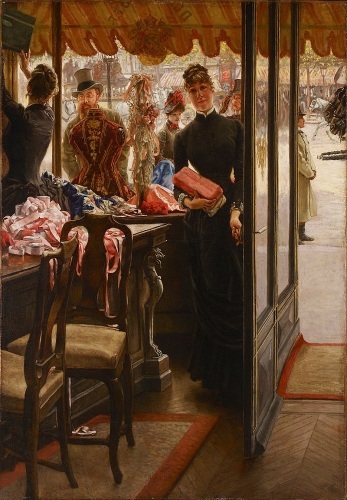A Lament for the Stores
Once upon a time, there were stores.
From my apartment in Boston, I could walk to two grocery stores. Granted, they were a Whole Foods and a Trader Joe’s, so it felt like living in a posher, more expensive area than I would have liked. The Whole Foods had actually replaced a health food store that had replaced a Market Basket. For anyone who doesn’t live in Boston, Market Basket is a local chain, founded by a local family, that serves ordinary middle-class communities. The health food store did not last long, because the community could not afford its more expensive offerings. The Whole Foods lasted a few years, but about a year after Whole Foods was acquired by Amazon, it left. That spot was empty for two years.
While the Whole Foods was still there, that strip also had a hardware store where I could buy all the things I needed to hang pictures (hammers, nails, those little bent things that the nails go into), lamps, ladders, cleaning supplies, unfinished wooden shelves, garden equipment, plants, and in December, Christmas trees. The landlord who owned that strip evicted the hardware store and built a metal awning, hoping the space would be filled with restaurants. So far it has been filled with one takeout place and one bubble tea shop. The rest of the space stands empty.
In the other direction, there used to be a Walgreens and a Gap, as well as a gourmet food store. The Walgreens went away first, to be replaced by a bank. Now there are four different banks in that area. The only drug store left is a CVS, which used to be a good CVS until the management brought in two checkout machines and reduced the number of clerks. At that point, the store started having a problem with shoplifting. So it put much of the merchandise behind plastic panels that have to be opened by a clerk. Did I mention there are not enough clerks? I’ve waited half a hour for a clerk so I can buy toothpaste. The Gap went away, as did the gourmet food store. Some of those places now stand empty, although the Gap was replaced by a daycare center, which is surely a good use of the space.
Near the university, the same sort of thing has happened. Once, in Kenmore Square, Boston University had a big, beautiful Barnes & Noble. It was three floors, filled with the most wonderful books, and on the first floor it had a café. I used to go there to meet graduate students and colleagues. Across the square was a Starbucks. The Starbucks left first, I don’t know why because it was quite heavily used by students. The building with the Barnes and Noble in it was sold, and now it’s some sort of office building advertising retail space on the first floor. No one has moved into it, so it’s just empty storefront. The new building next to it, which replaced a rather pretty although delapidated early 20th century structure, is the most boring building I have ever seen, made of prefabricated material that went up quickly. It has a sign on top that says WHOOP, so it must be the headquarters of the “wearable technology company” (I got that from the Internet) of that name. Honestly, I think they left off the final S — the building deserves a big sign that says WHOOPS. It also has empty storefront on the first level, with big fancy windows that look like dead eyes. The post office where I used to pick up packages and the corner convenience store where I used to buy chocolate no longer exist.
Kenmore square still has a bar and a few restaurants, but I don’t go there anymore. Why would I? There is nowhere to meet, sit down, have a cup of coffee. Nowhere to browse, nowhere to buy anything.
So many of the stores have gone. I lament the hardware store especially. Now, if I need the sort of thing that can only be bought in a hardware store, I must take the metro to Target or order from Amazon. I order from Amazon a lot more than I used to, not because I want to, but because I don’t have time to wait in CVS until a clerk can get away from watching the checkout machines to liberate a jar of face cream from its plastic prison.
It’s not a consistent phenomenon, of course, but it seems as though we’re losing the stores. I’m lamenting this for several reasons. First, I generally don’t want to buy something online. I want to see it, to make sure I like it, that it fits or that the proportions work. When I order something online, there’s a chance that, although I used measuring tape to make sure the lamp would be the right size, it is not, somehow, the right size after all. It doesn’t fit, and then I need to go through the further step of returning it. Second, I want to walk to the store. I want to walk and browse and get out of my apartment, see other people, listen to random conversations. I want to pick out my own apples and peaches.
I don’t know if this is a particularly American phenomenon, but in both Budapest and London, I was surrounded by stores. Budapest is the best, in that way — within a fifteen minute walk of my apartment there are about five different grocery stores. There are cafés, places to buy ice cream, a place to buy flavored cheesecake in little glass jars, a hummus bar, restaurants of all sorts, shops for both new and used clothing, stationery stores, book stores that sell Hungarian and German and English books, stores for ceramic flowers . . . And of course there is the Great Market Hall, where you can buy vegetables and meat and cheese from stalls. In some ways, except for the height of the buildings, Budapest is more like New York than Boston. In London last summer, I was in quite a posh area near Sloan Square, and many of the stores were expensive boutiques. Still, I could walk to three grocery stores and there was a Waterstones nearby. There were hardware stores and stationery stores in the general neighborhood.
The one good thing about my Boston neighborhood is that we do have an independent bookstore. It recently expanded, and it seems to be doing very well. But I lament the passing of the other stores. Whether they were chains like Gap or small boutiques, they gave us somewhere to go. I’m particularly sad that Kenmore Square has become a kind of corporate desert. The students deserve better. They chose to come to an urban university, and they deserve what a city should give everyone — a lively street culture. Cities need life and soul. Bostonians will remember the old Harvard Square, before it too became a kind of corporate desert. I still go there sometimes to buy office supplies from Bob Slate, but otherwise, why bother?
I don’t have any words of wisdom here — I’m just sad to see the city change, and I think it’s a bigger issue than one city, one neighborhood. I’m always glad when the trend reverses itself — after two years, the empty Whole Foods was replaced by an H Mart that seems to be doing a lively business. But if I’m living in a city, I want to live in a neighborhood with a grocery store, a pharmacy, and a hardware store that I can walk to. In a really ideal location, I also want a café and a bookstore. That does seem to be the minimum for good urban living?
I’m very lucky to live where I live and work where I work. But I miss the stores . . .

(The image is The Shop Girl by James Tissot.)



